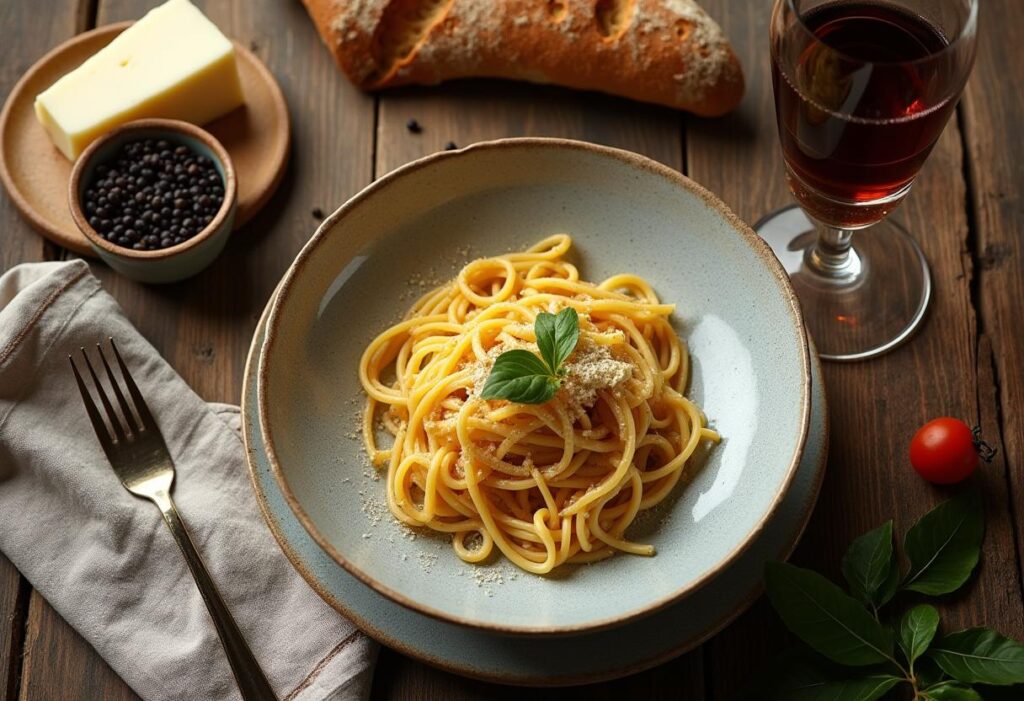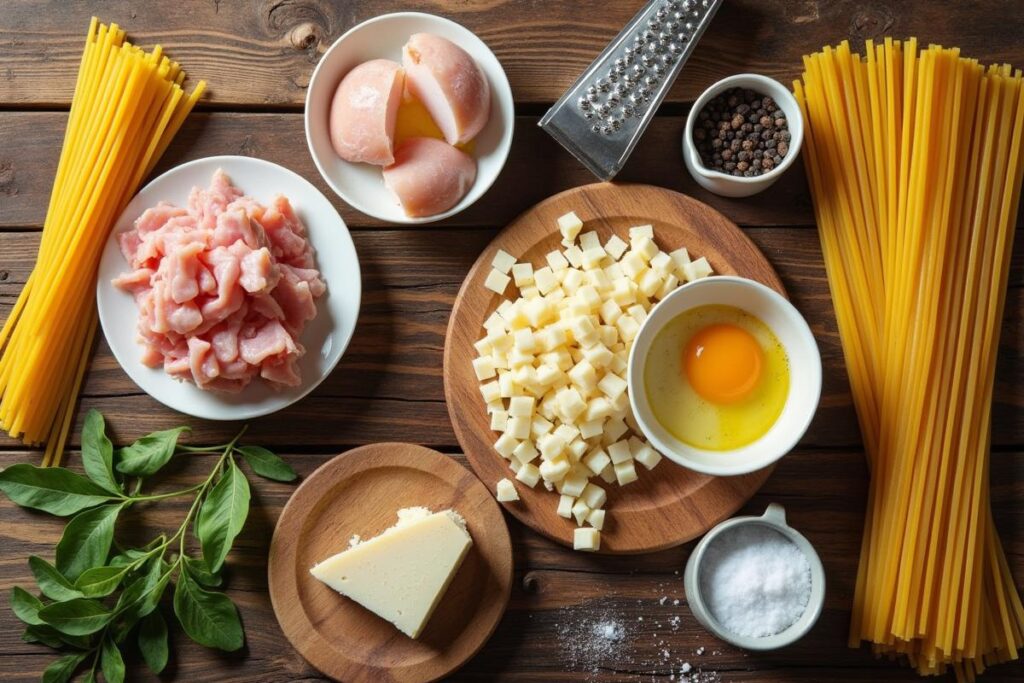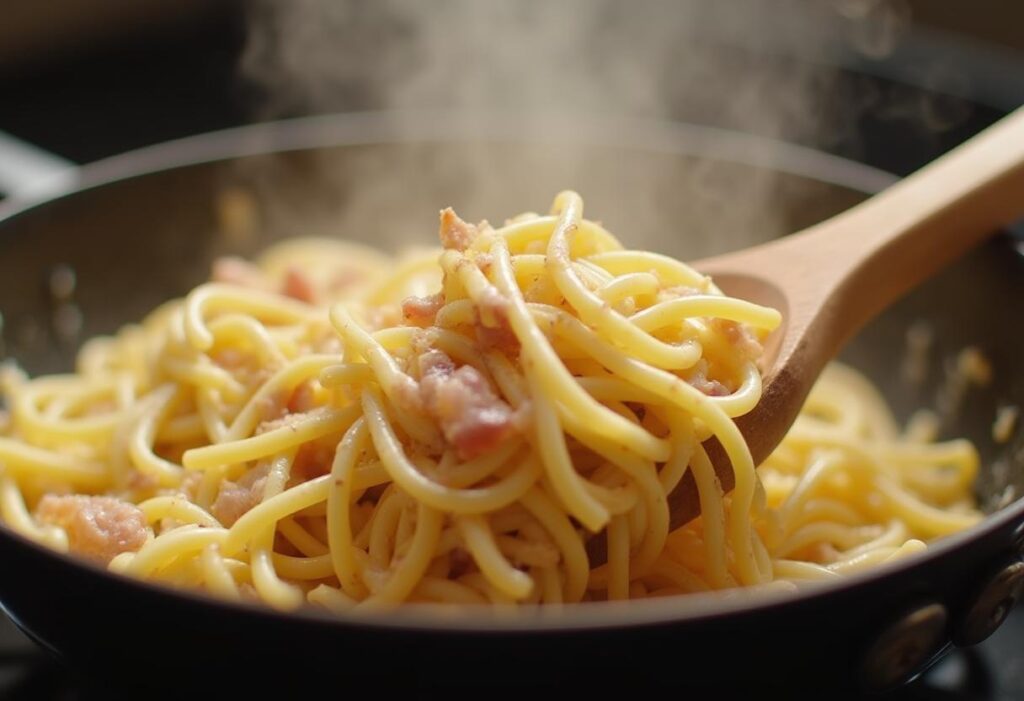There’s something magical about the creamy, savory goodness of pasta carbonara. It’s a dish that embodies the simplicity and elegance of Italian cuisine. As a food lover and recipe experimenter, I’ve tried (and failed) many times to master the art of making the perfect carbonara. Over the years, I’ve picked up secrets, uncovered common mistakes, and finally nailed the golden rule of carbonara. Whether you’re a seasoned cook or a beginner, this blog will guide you step-by-step through the process of creating an authentic pasta carbonara that’s sure to impress.

What is Pasta Carbonara?
What Makes Carbonara Unique?
Pasta carbonara is one of Italy’s most beloved dishes, celebrated for its simplicity and rich, creamy flavor. The recipe requires only a handful of ingredients – pasta, eggs, pecorino cheese, guanciale (Italian cured pork), and black pepper – yet when combined correctly, they create a luxurious, mouthwatering dish. What sets carbonara apart is its sauce, which relies on the perfect emulsion of eggs and cheese. There’s no need for heavy cream; the creaminess comes from skillful timing and mixing.
What’s truly fascinating about carbonara is how it marries bold, savory flavors with an incredibly smooth texture. The salty richness of guanciale, the sharp tang of pecorino, and the slight heat from freshly cracked black pepper come together to create a dish that feels indulgent but remains surprisingly light.
The Origins of Pasta Carbonara
The origins of pasta carbonara are shrouded in culinary legend. Most food historians trace the dish back to the Lazio region of Italy, particularly Rome, in the mid-20th century. While some claim it was created by Italian charcoal workers (carbonaro in Italian), others believe it emerged during World War II when American soldiers introduced bacon and powdered eggs to Italian cooks.
Regardless of its exact roots, carbonara has become a symbol of Italian comfort food. Authentic recipes emphasize quality ingredients and traditional techniques, which honor the simplicity and heritage of this classic dish.
Today, pasta carbonara remains a favorite on menus worldwide, with countless adaptations and interpretations. However, the best versions always stick to the basics – because when done right, the original needs no improvement.
Key Ingredients for an Authentic Pasta Carbonara
The Core Ingredients You Need
The magic of pasta carbonara lies in its simplicity, which means every ingredient plays a critical role. To create an authentic dish, here’s what you’ll need:
- Pasta: The traditional choice is spaghetti, but rigatoni, bucatini, or fettuccine can also work well. Look for high-quality dried pasta made from durum wheat for the best texture.
- Guanciale: This cured pork cheek is the soul of carbonara. Its rich, fatty flavor adds depth to the dish. If guanciale isn’t available, pancetta can serve as a substitute, but it won’t deliver the same authenticity.
- Eggs: Whole eggs and egg yolks are essential for the creamy sauce. The balance is key – typically, a mix of 2 egg yolks for every whole egg works beautifully.
- Pecorino Romano Cheese: This sharp, salty sheep’s milk cheese is the traditional choice. Some recipes may include a blend of pecorino and parmesan, but purists prefer pecorino for its authentic flavor.
- Freshly Cracked Black Pepper: This isn’t just a seasoning – it’s a key flavor in carbonara. Use freshly cracked pepper for its robust aroma and taste.

Which Ingredients Should Never Be Used?
Although carbonara has been adapted worldwide, certain ingredients are considered taboo in traditional recipes:
- Cream: One of the biggest misconceptions is that carbonara requires cream. In authentic recipes, the creaminess comes from the emulsion of eggs, cheese, and starchy pasta water.
- Garlic or Onions: While these ingredients are common in Italian cooking, they have no place in traditional carbonara.
- Butter: Guanciale’s rendered fat provides all the richness needed – adding butter overwhelms the dish.
By sticking to these core ingredients, you’ll achieve an authentic carbonara that’s full of flavor and true to its Roman roots. The quality of each item is crucial, so choose the best you can find.
The Golden Rule of Cooking a Carbonara
Timing: The Secret to Perfection
The golden rule of cooking pasta carbonara lies in mastering the timing. The creamy sauce is made by combining the egg mixture with the hot pasta – and this delicate process requires precision. The eggs should cook gently from the heat of the pasta, creating a silky emulsion without scrambling.
Here’s how timing plays a role:
- Cook the Pasta Al Dente: Start by boiling your pasta in salted water until it’s just al dente. This ensures the pasta is firm enough to hold the sauce without becoming mushy.
- Prepare the Guanciale Simultaneously: While the pasta cooks, render the guanciale in a pan over medium heat until it’s crispy. Be sure to reserve the flavorful fat in the pan – it’s key to the sauce.
- Combine Everything Immediately: As soon as the pasta is drained, it should be tossed with the guanciale and its rendered fat while still hot. This is where the magic happens – the heat from the pasta and pan is what gently cooks the egg mixture.
Avoiding Common Mistakes in Carbonara Preparation
To achieve carbonara perfection, avoid these common pitfalls:
- Too Much Heat: Adding the egg mixture to pasta that’s overly hot will scramble the eggs. Always remove the pan from direct heat before combining.
- Skipping the Pasta Water: The starchy water from cooking the pasta is essential for loosening the sauce and ensuring it clings to every strand. Reserve at least a cup before draining.
- Overcooking the Pasta: Undercooked pasta is better than overcooked since it will continue to cook slightly when tossed with the sauce.
The golden rule boils down to this: work quickly, keep your ingredients hot (but not too hot), and let the heat of the pasta do all the work.
Step-by-Step Recipe for Traditional Pasta Carbonara
Ingredients Checklist for Three Servings
| Ingredient | Quantity | Notes |
|---|---|---|
| Spaghetti or Rigatoni | 300g (10.5 oz) | Use high-quality durum wheat pasta for the best texture. |
| Guanciale | 100g (3.5 oz) | Diced into small cubes. Pancetta can be a substitute, but guanciale is preferred. |
| Egg Yolks | 2 large yolks | Fresh, room-temperature eggs work best for emulsifying the sauce. |
| Whole Egg | 1 large egg | Combined with the yolks for extra creaminess. |
| Pecorino Romano Cheese | 70g (2.5 oz) | Finely grated for easy incorporation into the sauce. |
| Freshly Cracked Black Pepper | To taste | Adds flavor and spice – be generous! |
| Salt | For pasta water | Essential for seasoning the pasta as it cooks. |
How to Prepare the Sauce Properly
The sauce is the heart of carbonara, and getting it right requires just a few key steps:
- Whisk the Eggs and Cheese: In a small bowl, whisk the egg yolks, whole egg, and grated Pecorino Romano until smooth. Add a generous amount of freshly cracked black pepper and mix thoroughly. Set aside.
- Cook the Guanciale: In a large pan, cook the guanciale over medium heat until it becomes crispy and releases its fat. This should take about 5-7 minutes. Once done, turn off the heat but leave the rendered fat in the pan.
Cooking and Assembling the Dish
- Cook the Pasta: Bring a large pot of salted water to a boil and cook the pasta until it’s al dente. Reserve at least 1 cup of the starchy pasta water before draining.
- Combine Pasta with Guanciale: Add the drained pasta to the pan with the guanciale and toss to coat the noodles in the rendered fat. Work quickly to ensure the pasta stays hot.
- Add the Egg Mixture: Remove the pan from direct heat and pour the egg and cheese mixture over the pasta. Toss vigorously to combine. The residual heat from the pasta will cook the eggs gently, creating a creamy sauce.
- Adjust the Sauce: If the sauce is too thick, add small amounts of reserved pasta water, one tablespoon at a time, until the desired consistency is achieved.
- Serve Immediately: Divide the pasta into individual plates, sprinkle with additional Pecorino Romano and black pepper, and serve hot.
Pro Tips for Success
- Always use freshly grated Pecorino Romano for better texture and flavor.
- Stir constantly when adding the egg mixture to avoid scrambling the eggs.
- Serve carbonara immediately – it’s best enjoyed fresh, while the sauce is creamy and warm.

Common Mistakes to Avoid When Making Carbonara
Biggest Carbonara Blunders
Even though pasta carbonara is simple, many cooks fall into common traps that can ruin the dish. Here are the biggest mistakes and how to avoid them:
- Scrambling the Eggs: This is the number one mistake when making carbonara. If the pan is too hot when you add the egg mixture, it will scramble instead of creating a creamy sauce. Always remove the pan from direct heat before adding the eggs, and toss vigorously to blend.
- Adding Cream: While many recipes include heavy cream, authentic carbonara relies on the emulsion of eggs, cheese, and pasta water for its rich texture. Cream masks the delicate flavors of the dish.
- Overcooking the Guanciale: Guanciale should be crispy but not burned. Cooking it over medium heat and stirring frequently ensures it releases its fat evenly and achieves the perfect texture.
- Skipping the Pasta Water: The starchy water from cooking the pasta is critical for achieving the right sauce consistency. Always reserve at least a cup before draining the pasta.
- Using Pre-Grated Cheese: Pre-grated cheese often contains anti-caking agents, which can prevent the sauce from blending smoothly. Use freshly grated Pecorino Romano for better flavor and texture.
How to Fix a Runny or Clumpy Sauce
If your sauce isn’t coming out as planned, here’s how to troubleshoot:
- Runny Sauce: Add more grated cheese to thicken it, or toss the pasta on low heat for a few seconds while stirring to help the sauce bind.
- Clumpy Sauce: This often happens if the pan is too hot when you add the eggs. To fix it, stir in a bit of pasta water and vigorously toss to smooth it out.
Avoiding these pitfalls ensures your carbonara is creamy, flavorful, and irresistibly delicious every time.
Variations of Pasta Carbonara Around the World
Regional Takes on the Classic Recipe
While authentic pasta carbonara is a Roman dish with strict guidelines, its popularity has led to regional and global variations. These interpretations add a unique twist to the classic recipe while retaining its comforting essence.
- American-Style Carbonara: In the United States, cream is often added to the sauce to guarantee creaminess, even though it’s not traditional. Additionally, bacon or smoked pancetta frequently replaces guanciale, giving the dish a smokier flavor.
- Vegetarian Carbonara: To accommodate vegetarians, some versions swap guanciale for mushrooms or smoked eggplant. The umami flavors of these ingredients provide a satisfying alternative to meat.
- Japanese Carbonara: Japanese interpretations often use udon noodles instead of pasta. The sauce incorporates soy sauce, butter, and sometimes miso for a distinct Asian twist.
- Carbonara with Seafood: In coastal areas, shrimp or scallops replace guanciale, creating a seafood version of carbonara. This variation pairs particularly well with white wine and lemon zest.
Modern Twists on Carbonara
Contemporary chefs have taken liberties with carbonara to experiment with new flavors and techniques:
- Carbonara with Truffle: Adding fresh truffle shavings or truffle oil elevates the dish to a luxurious treat. The earthy aroma pairs wonderfully with the creamy sauce.
- Zucchini Carbonara: For a lighter version, some cooks incorporate zucchini ribbons or zoodles (zucchini noodles) alongside or instead of traditional pasta.
- Vegan Carbonara: Plant-based carbonara substitutes eggs with cashew cream or silken tofu and uses smoked tempeh or coconut bacon in place of guanciale. Nutritional yeast stands in for Pecorino Romano to deliver that cheesy flavor.
- Gluten-Free Carbonara: Gluten-free pasta, made from rice or chickpeas, allows those with gluten sensitivities to enjoy this Italian classic.
These variations show how adaptable and beloved pasta carbonara is worldwide. Whether you’re sticking to tradition or trying something new, carbonara remains a versatile dish that caters to all tastes and dietary needs.
Nutritional Facts About Pasta Carbonara
Calories and Macronutrients
Pasta carbonara is undoubtedly a rich dish, making it perfect for a satisfying meal. Here’s a breakdown of its nutritional content based on a typical serving size (about 100g or 3.5 oz):
| Nutrient | Amount per Serving | Notes |
|---|---|---|
| Calories | ~400–450 kcal | Varies based on portion size and ingredient quality. |
| Protein | ~15–18g | Mainly from the eggs, cheese, and guanciale. |
| Fats | ~20–25g | Includes healthy fats from eggs and guanciale. |
| Carbohydrates | ~35–40g | Primarily from the pasta, a great source of energy. |
| Sodium | ~500–700mg | Comes from the cheese, guanciale, and salted pasta water. |
| Dietary Fiber | ~2–3g | Depending on the type of pasta used. |
Healthier Substitutes Without Losing Flavor
Although carbonara is rich and indulgent, you can make small substitutions for a slightly healthier version:
- Swap Guanciale for Leaner Meat: Use turkey bacon or prosciutto for less fat while retaining some of the smoky flavor.
- Choose Whole-Grain Pasta: Whole-grain pasta adds more fiber and nutrients without sacrificing taste.
- Use Egg Whites: Replace one or more yolks with egg whites to reduce fat and cholesterol.
- Add Vegetables: Incorporating spinach, peas, or mushrooms can boost the dish’s fiber and vitamin content.
- Reduce the Cheese: Cut down the amount of Pecorino Romano or mix it with a lighter cheese like parmesan.
While traditional pasta carbonara isn’t considered a “light” dish, small tweaks can make it a healthier option without compromising the creamy, flavorful experience it offers.
FAQ Section on Pasta Carbonara
What is the golden rule of cooking a carbonara?
The golden rule of cooking pasta carbonara is to use the residual heat of the pasta to cook the egg mixture gently. Never add the eggs to a pan that is too hot, as this will scramble them. Always remove the pan from direct heat before combining the pasta and sauce and toss quickly to create a creamy texture.
What is the sauce in carbonara made of?
The sauce in traditional carbonara is made of just a few simple ingredients: eggs (yolks and sometimes a whole egg), Pecorino Romano cheese, freshly cracked black pepper, and the rendered fat from guanciale. The creamy texture comes from emulsifying these ingredients with the starchy pasta water.
Which ingredient should never be used in traditional carbonara?
Cream should never be used in traditional carbonara. The creaminess comes from the emulsion of eggs, cheese, and pasta water, so adding cream is unnecessary and alters the authentic flavor of the dish.
How many eggs for 3 people carbonara?
For three people, use 2 large egg yolks and 1 whole egg. This combination provides the perfect creaminess without being overly rich.
What ingredients are in carbonara?
Authentic pasta carbonara requires the following ingredients:
– Pasta (typically spaghetti or rigatoni)
– Guanciale (or pancetta as a substitute)
– Eggs (yolks and sometimes a whole egg)
– Pecorino Romano cheese
– Black pepper
– Salt (for pasta water)
What are the biggest carbonara mistakes?
The most common mistakes include:
1. Scrambling the eggs by adding them to overly hot pasta or a hot pan.
2. Using cream, which is not authentic.
3. Skipping the pasta water, which is essential for creating the perfect sauce consistency
Tips for Pairing Pasta Carbonara with Wine and Sides
Perfect Wine Pairings for Carbonara
The rich, creamy, and savory flavors of pasta carbonara make it a perfect candidate for wine pairing. Here are some great choices to complement the dish:
- White Wines:
- Pinot Grigio: Its crisp acidity cuts through the richness of the sauce, providing a refreshing balance.
- Chardonnay: Opt for an unoaked or lightly oaked variety to enhance the creamy texture of the carbonara without overpowering it.
- Sauvignon Blanc: Its herbaceous and zesty notes offer a nice contrast to the guanciale’s salty richness.
- Red Wines:
- Chianti Classico: This medium-bodied red from Tuscany brings earthy and fruity notes that pair well with the smoky flavors of guanciale.
- Pinot Noir: Light and fruity, this wine complements the dish’s subtle flavors without overwhelming the palate.
- Sparkling Wines:
- A dry Prosecco or Brut Champagne adds a touch of elegance and refreshes the palate with every bite.
Side Dishes That Complement Carbonara
Since carbonara is a rich and filling dish, lighter sides work best to balance the meal. Here are some great options:
- Simple Salads: A crisp green salad with a light vinaigrette adds freshness to the meal. Consider arugula, spinach, or mixed greens with lemon dressing.
- Grilled Vegetables: Lightly charred zucchini, asparagus, or bell peppers provide a smoky and earthy complement to the creamy pasta.
- Garlic Bread: A slice of crispy garlic bread makes a comforting side without stealing the spotlight from the carbonara.
- Roasted Tomatoes: The sweetness of oven-roasted cherry tomatoes pairs beautifully with the salty, creamy flavors of the dish.
Pairing carbonara with the right wine and sides elevates the dining experience, making it a meal to savor and remember.
Conclusion: Enjoying the Perfect Pasta Carbonara
The Essence of Perfect Carbonara
Pasta carbonara is a true testament to the beauty of simplicity. With just a handful of ingredients – pasta, guanciale, eggs, Pecorino Romano, and black pepper – this dish captures the essence of Italian culinary tradition. The key lies in precision and care: properly timing the cooking process, gently emulsifying the sauce, and respecting the authenticity of the ingredients. When these elements come together, carbonara transforms into a dish that’s creamy, savory, and utterly satisfying.
How to Experiment and Make It Your Own
While sticking to tradition is ideal, there’s always room for creativity in your kitchen. Whether it’s adding a sprinkle of truffle, substituting guanciale with mushrooms for a vegetarian version, or pairing it with a bold Chianti or a crisp Sauvignon Blanc, you can personalize carbonara to suit your taste and occasion.
As you enjoy this iconic dish, remember that the heart of carbonara lies in its simplicity and balance. By following the golden rule of timing and avoiding common mistakes, you’ll have a dish that feels like a warm, comforting hug on a plate. So, gather your ingredients, pour a glass of wine, and savor every bite of your perfectly crafted pasta carbonara. Buon appetito!
Discover great tips for cooking Italian pasta dishes like Ronzoni Lasagna!
